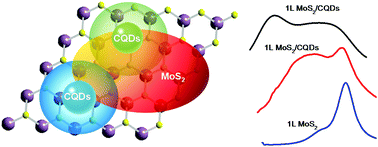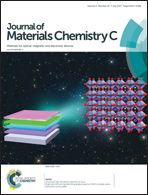Towards full-colour tunable photoluminescence of monolayer MoS2/carbon quantum dot ultra-thin films†
Abstract
Due to the limitations of excitonic energy and band structure, monolayer (1L) MoS2 can only emit a narrow band of red light. Herein, we bypassed this restriction by coating 1L-MoS2 with an ultra-thin layer of highly luminescent carbon quantum dots (CQDs). These novel 1L-MoS2/CQD ultra-thin films exhibit multiple emission bands, including red light bands belonging to MoS2 and tunable bands belonging to the CQDs. A balanced intensity of these bands can be obtained by optimizing the thickness of the CQDs to ∼10 nm. By varying the excitation wavelength, the emission band of these 1L-MoS2/CQD ultra-thin films can be modulated from 550–700 nm to 450–700 nm, resulting in tunable light emission from orange (CIE0.5149, 0.3766) to yellow-green (CIE0.3175, 0.4509). These tunable emission bands are much broader than those of 1L-MoS2. However, to date, this full-color tunable emission has not been observed in other 1L-MoS2/QD thin films prepared using graphene oxide quantum dots (GOQDs) or graphene quantum dots (GQDs).



 Please wait while we load your content...
Please wait while we load your content...